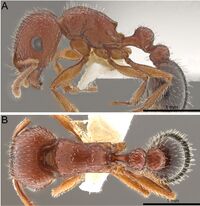Tetramorium brigitteae
| Tetramorium brigitteae | |
|---|---|

| |
| Scientific classification | |
| Kingdom: | Animalia |
| Phylum: | Arthropoda |
| Class: | Insecta |
| Order: | Hymenoptera |
| Family: | Formicidae |
| Subfamily: | Myrmicinae |
| Tribe: | Crematogastrini |
| Genus: | Tetramorium |
| Species group: | solidum |
| Species: | T. brigitteae |
| Binomial name | |
| Tetramorium brigitteae Mbanyana, Robertson & Hita Garcia, 2018 | |
Known from the lone worker type, collected from the Nama Karoo region in the Northern Cape in South Africa.
Identification
Mbanyana et al (2018) - Tetramorium brigitteae is morphologically similar to Tetramorium peringueyi, Tetramorium dichroum and Tetramorium margueriteae. These are the only species in the T. solidum species group with abundant erect simple hairs covering the entire body. Tetramorium brigitteae can be easily separated from T. peringueyi by the following characters: in T. brigitteae, dorsum of mesosoma with longitudinal striations and superficial ground sculpture in between, whereas in T. peringueyi, the dorsal surface of the mesosoma with strongly developed irregular reticulate sculpture; propodeum armed with a pair of short propodeal teeth (PSLI 6) in T. brigitteae, whereas in T. peringueyi the propodeum is armed with elongate spines (PSLI 22). Antennae with sub-erect pubescence in T. brigitteae, with erect hairs in T. peringueyi. Tetramorium brigittae can also be easily separated from T. margueriteae on the basis of colour and spine length, and also by the fact that T. margueriteae has erect hairs on the antennae, whereas T. brigitteae has sub-erect pubescence on the antennae. Tetramorium brigitteae and T. dichroum both have sub-erect hairs on the antennae, and in both species the dorsum of the mesosoma has longitudinal striations and a superficial ground sculpture in between. These two species can be separated on the basis of spine length and colour. In T. brigitteae, propodeum armed with short propodeal teeth (PSLI 6), whereas in T. dichroum propodeum armed with acute spines (PSLI 14). Tetramorium brigitteae is reddish brown, with gaster black, whereas T. dichroum is light brown in colour, with gaster a little darker compared to the mesosoma. The lateral sides of the mesosoma have strong reticulate-punctate sculpture in T. brigitteae, whereas in T. dichroum the sides of the mesosoma have lateral striations with a superficial reticulate sculpture in between.
Keys including this Species
Distribution
Latitudinal Distribution Pattern
Latitudinal Range: -28.623° to -28.623°.
| North Temperate |
North Subtropical |
Tropical | South Subtropical |
South Temperate |
- Source: AntMaps
Distribution based on Regional Taxon Lists
Afrotropical Region: South Africa (type locality).
Distribution based on AntMaps
Distribution based on AntWeb specimens
Check data from AntWeb
Countries Occupied
| Number of countries occupied by this species based on AntWiki Regional Taxon Lists. In general, fewer countries occupied indicates a narrower range, while more countries indicates a more widespread species. |

|
Estimated Abundance
| Relative abundance based on number of AntMaps records per species (this species within the purple bar). Fewer records (to the left) indicates a less abundant/encountered species while more records (to the right) indicates more abundant/encountered species. |

|
Biology
Castes
Nomenclature
The following information is derived from Barry Bolton's Online Catalogue of the Ants of the World.
- brigitteae. Tetramorium brigitteae Mbanyana, Robertson & Hita Garcia, 2018: 13, figs. 4J, 7, 24 (w.) SOUTH AFRICA.
Unless otherwise noted the text for the remainder of this section is reported from the publication that includes the original description.
Description
Worker
(N = 1) HL 0.982; HW 1.059; SL 0.736; EL 0.284; PH 0.374; PW 0.672; WL 1.098; PSL 0.054; PTH 0.364; PTL 0.349; PTW 0.375; PPH 0.452; PPL 0.362; PPW 0.426; OI 27; CI 108; SI 70; DMI 61; LMI 34; PSLI 6; PeNI 56; LPeI 96; DPeI 107; PpNI 63; LPpI 80; DPpI 118; PPI 114.
Holotype Mandibles with fine longitudinal striations. Anterior clypeal margin with extensive and deep indentation. Frontal carinae extending back to posterior margins of eyes. Eyes with 16 ommatidia in longest row. Propodeum armed with pair of short propodeal teeth (PSLI 6), teeth longer than basal width. Metapleural lobes low and rounded. Peduncle with prominent keel-shaped subpetiolar process. Petiolar node in profile nodiform, with posterior face slightly more steeply angled than anterior face; anterior face rounding into dorsum but with slightly angled corners as seen in dorsal view. Postpetiolar node low and rounded. Peduncle lacking subpetiolar process. Dorsal surfaces of head and mesosoma with longitudinal striations, spaces between them with superficial ground sculpture. Petiolar and postpetiolar nodes with fine reticulate sculpture overlain by few irregular transverse striations. Gastral tergite with longitudinal short striations basally and remaining part with fine reticulate pattern. All dorsal surfaces of body with abundant, short to moderately long, erect pilosity. Antennae with sub-erect pubescence. Tibia of middle and hind legs with numerous short, stout, erect hairs. Ventral surface of head with strongly developed psammophore. Head and mesosoma light brown in colour and gaster black.
Type Material
Holotype. South Africa: Northern Cape: worker, near Augrabies Falls National Park, on R359 past turnoff for Augrabies National Park, 28.623° S, 20.328° E, 639 m a.s.l., 13 Dec. 2011, Brigitte Braschler (SAM-HYM-C027040). South African Museum
Etymology
Named after Dr Brigitte Braschler who collected the holotype and who has made a significant contribution to our knowledge of southern African arid ants through field work conducted as part of the DST/NRF Centre of Excellence for Invasion Biology’s Imbovane project.
